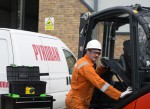Taking responsibility for repairs to Ex-rated motors
Published: 06 January, 2021
Karl Metcalfe, technical support for the AEMT, looks at the knowledge and responsibilities that are expected when it comes to managing electric motors in zoned areas.
Operating equipment in potentially explosive atmospheres comes with a certain amount of responsibility, not least to use correctly designed components that have the features necessary for the environment. When maintenance and repairs are required, it is important that operators understand what is expected of them to ensure continued safety and reliability.
Potentially explosive atmospheres are commonly encountered in many industrial sectors including oil & gas, pharmaceuticals, water treatment, mining as well as the food and beverage industry. Specific areas that may be affected are zoned according to the potential risks and any electrical equipment in these areas must be designed and manufactured to specific standards.
International standards
Any business that has identified zoned areas within its processes is expected to adhere to a number of international and regional standards including BS EN IEC 60079-19:2019. This states the responsibilities of operators, managers and repairers to ensure that all equipment is properly maintained and fit for continued service.
Equipment that is designed for Ex zoned areas uses a variety of protection concepts to ensure safe operation. Different concepts can be used in similarly zoned areas, and it is important that site maintenance engineers understand these concepts so that they do not compromise the equipment.
For example, periodic inspections and maintenance checks that involve the removal of a terminal box lid from an Ex d machine may discover corrosion has occurred. At this point, it may be necessary to check the flamepath gaps and establish if they are still sufficient for the zoned area in which the equipment is operating.
Repair essentials
When the time comes for a repair or overhaul, Ex equipment needs to be sent to a repairer that is qualified to complete the work. The international standard emphasises that it is the responsibility of the operator to ensure that any maintenance work is delivered by those with sufficient facilities and competencies. Moreover, each piece of equipment should have its own dossier containing all the required paperwork, including details of any previous repairs and inspections. A copy of this should accompany the equipment to any approved service centre, ensuring that all available information is on-hand for the repair process.
A properly qualified repair centre will ask for this information and they will also provide all the evidence required to determine if it is qualified to deliver the repair. It is important to stress that the owner of the equipment is responsible for establishing this fact and retaining this evidence in the equipment dossier.
Minimising risks
Following the guidelines and taking on the responsibilities of operating exrated equipment goes a long way to minimising the risks associated with zoned areas, keeping both employees and equipment safe. Conversely, the implications of failing to adhere to the international standard could have significant consequences, hopefully not for any personnel, but the damage to the business can be substantial.
In the event of an incident involving equipment in a zoned area, assuming no injuries were sustained, the first step to recovering the process will involve the insurance company. The investigation into the cause of the incident will start with the information dossier for all the equipment in the affected area, especially any component that is judged to be the root cause.
If any repairs have been completed by service centres that did not comply with the international standard, this could be seen as a failure to meet the terms of the insurance policy. As such, this could have major implications for funding any repairs as well as increasing the cost of future insurance policies.
Improving knowledge
Both managers and maintenance staff involved with Ex rated equipment are encouraged to broaden their knowledge of this specialised area and attend training courses appropriate for their role. This will enable the business to implement the necessary operational and managerial processes to comply with the international standard.
To provide further assistance, the AEMT has an Ex register (www.ex-register.com) which lists all members that hold various certifications including ISO 9001, and AEMT Ex Assessment Certificates. IECEx service centres are independently audited by a notifying body and maintain their 3-year refresher training to achieve certified accreditation.
https://twitter.com/AEMT_Updates https://www.linkedin.com/company/the-association-of-electrical-and-mechanical-trade/






 Explosion protection safety company PYROBAN reports it has responded to industry demand by providing technical support for any ATEX forklift truck, regardless of the brand of explosion protection system. “Not all explosion protection conversion companies have the infrastructure to offer the ongoing support and service needed in a typical hazardous area operation,” explains Darren Boiling, group after sales manager, “To maintain safety and avoid truck downtime, managers must be aware of where they can access the correct technical support.”
Explosion protection safety company PYROBAN reports it has responded to industry demand by providing technical support for any ATEX forklift truck, regardless of the brand of explosion protection system. “Not all explosion protection conversion companies have the infrastructure to offer the ongoing support and service needed in a typical hazardous area operation,” explains Darren Boiling, group after sales manager, “To maintain safety and avoid truck downtime, managers must be aware of where they can access the correct technical support.”
